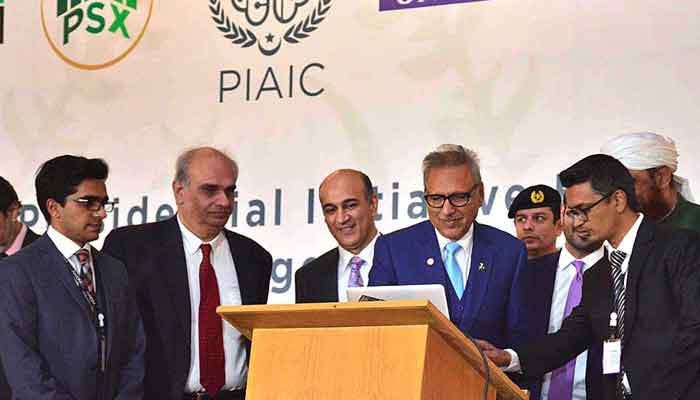Pakistan’s place in Artificial Intelligence and computing
In the world of science and technology, it is being said that we are at the beginning of the Fourth Industrial Revolution. The first that lasted from 1760 to 1840 brought in the age of mechanized production. It was the result of new materials like iron and steel, which combined with new energy resources of coal and steam, led to ‘mass production’, and a factory system with division of labor.
The second industrial revolution from 1870 to the early part of 20th century was the result of electricity, and the internal combustion engine. Both powered industrial machines and made transport possible. Besides this for the first time, communication of messages by telephone and telegraph did not involve physical movement of messengers. Raw human physical labour yielded to machines, while ideas started moving very fast in the ether surrounding us. Mass production led to huge gains and opened the way for individualised mass consumption of today.
The third revolution that followed 60 years later was the digital revolution of information technology and most of you who read these lines have seen it happen. It was brought in by semiconductors, mainframe computing, silicon, personal computing, cellphones and the internet. The world wide web, sensors and cameras, combined with increasing ability to acquire and store data in the last two decades, has led to an exponential increase in data itself which has left the ability to analyse it, phenomenally mismatched and far behind.
The fourth industrial revolution has now begun, and Pakistan must step in to take part in shaping this change to benefit from the fruits the world has yet to see. The ability of technology to crunch data and then to extract valuable information from billions of inputs in a matter of milliseconds has been improving exponentially since the last few decades. It is marked by emerging technology breakthroughs primarily in the following ten areas, Artificial Intelligence, Robotics, Internet of Things, 5G Broadband, 3D printing, Autonomous Vehicles, Cloud Computing, Blockchain like Distributed Ledgers Technology, Biotechnology and Precision Medicine, and Augmented Reality.
Klaus Schwab in his book ‘The Fourth Industrial Revolution’ states that previous industrial revolutions liberated man from animal power, made mass production possible and brought digital capabilities to billions of people, but the fourth is fundamentally different. It is characterized by a range of new technologies that are fusing the physical, digital and biological worlds, impacting all disciplines, economies and industries, and even challenging ideas about what it means to be human.
Reasoning has been the biggest strength of humankind but now it can be relegated to machines, to potentially be performed at a magnitude that could not have been imagined before. Raw, brute crunching of data was done earlier by super computers like the IBM Deep Blue, that defeated Gary Kasporov in 1997. Deep Blue was tutored in the basics of chess and had in its memory the strategy employed by grandmasters in thousands of games previously played. It could evaluate 200 million positions every second and had a significant advantage over its human combatant in that it was accurate, tireless, and remembered millions of calculations while considering its future moves.
Now, this year, comes along a machine learning program, AlphaZero made by Alphabet, that has a unique Algorithm, the latter term being a latinisation of the name of Al-Khwarizmi who also authored the science of ‘Algebra’. AlphaZero’s algorithm for learning of chess, started with no knowledge of the game beyond it basic rules, the way a human would start, but then it played against itself millions of times and learned from its mistakes. Confoundingly in a matter of hours it taught itself enough to take on the best computational beast in chess that existed, the program called ‘Stockfish’. AlphaZero thought smarter not faster. While Stockfish was using brute computational force to calculate chess moves with 60 million calculations per second, AlphaZero with its self-learning algorithms examined only 60,000 calculations per second and beat Stockfish hollow. In a nutshell this is Artificial Intelligence and machine learning. While we register this, consider it to be stone age compared to ‘quantum’ computing, that may soon become a reality.
The convergence of data with massive storage and analytical abilities when applied to available genomic and health data will be creating phenomenal change in human health. ‘Epic’ for example, a US health service provider, has trillions of health data-points on more than 100 million people. The analysis of such meta-data can exponentially improve diagnostics, treatment, and even prediction of disease that may emerge in a population. An AI-based machine at Manchester University has discovered a compound effective against drug-resistant malaria. ReLeaSE another algorithm-based computer program comprises two neural networks that can be thought of as a teacher and a student. The teacher neural network knows the rules behind chemical structures of about 1.7 million known biologically active molecules. By working with the teacher, the student neural network learns over time and becomes better at proposing molecules that are likely to be useful in new drugs. Combining CRISPR the gene sequencing and editing technology with AI drug development programs can dramatically revolutionise health care.
New drugs combined with advanced diagnostic tools will lead to effective personalized treatments. Augmented reality and virtual reality will overlay data related information on the real world whether meant for travel, or even in surgery where layers of tissue shall not have to be dissected in search for diseased foci as the surgeon would be able to see the whole thing in three dimensions before dissection. Doctors may be able to implant living cells that will not be targeted by body’s own immune processes, to manufacture effective drugs within the body.
Artificial Intelligence is a dual use technology. Besides commercial applications it also has a major use in the military, in aerial warfare, avionics, smart bombs, weaponized drones, even in disinformation campaigns and cyber security.
Increasingly machines, for example autonomous vehicles are making decisions with little intervention by humans. Some understanding of this new reality, though in its infancy has enabled, seven out of top ten largest companies of 2018, Apple, Amazon, Alphabet, Microsoft, Facebook, Ali Baba and Tencents to become economic powerhouses of this decade. Societies that cope positively with the technological impact of the fourth industrial revolution will have a far better economic and social future. Pakistan should have the know-how and vibrancy to absorb this new wave like a sponge and soak our abundant youth into a fast-track learning phenomenon that will change our destiny.
The economic footprint of this emerging revolution is enormous. While 90% of future jobs will require some level of digital literacy, augmented reality alone currently valued at $ 2 Billion is expected to grow to $ 200 Billion in two years. According to Gartner Inc., in 2020 AI will become a positive net job motivator creating 2.3 million jobs. Soft-tech openings in Canada alone are forecast to reach 200,000 by the year 2020 and it has tweaked up its immigration programs to welcome such specialists. Global business value derived from artificial intelligence will increase from a value of $692 Million in 2017 to $1.2 trillion in 2018, and it is forecast to reach $3.9 trillion by 2022. Out of this huge chunk, in my discussions with the Pakistani diaspora in the Silicon Valley, they are optimistic that if the right decisions are made, Pakistani software exports may even reach $ 30 Billion by 2023. Optimistic it may be, but we should accept this challenge as it does not require brick and mortar investment but only intellectual upgradation of our educated youth.
Pakistan needs to be well placed, as our future economy and defense systems will strongly depend on our own skills to be a part of the great revolution that is knocking on our doorsteps. Rather than be a consumer that makes us totally dependent on foreign software and hardware even at crucial times, we must become a player and manufacturer of the new systems ensuring phenomenal economic dividends as well as our own security. We are going to produce this new talent for Pakistan, but their skills will also be in huge demand throughout the world.
Why don’t I find Pakistan in this booming landscape? There is a consensus that the software engineers we produce are not what the market demands. This mismatch needs to be corrected by a responsive, dynamic curriculum in our universities. For this I would be working with the Vice Chancellors of the universities that come under the patronage of the President as Chancellor. However, for our immediate needs, as this software world is changing too fast, we have decided to top-up the knowledge of existing software engineers, and to train new comers also, in a crash course for 100,000 youth this year, under the President’s Initiative on Artificial Intelligence and Computing. The program can be viewed at www.PIAIC.org
John Dewey, the American philosopher-educationist, very appropriately said that ‘If we teach today’s students as we taught yesterdays, we rob them of tomorrow’. Let us give tomorrow, today to the Pakistani youth.
The author is President of Pakistan
-
 Gabriel Diallo Vs Alexander Zverev: Rising Canadian Eyes Major Upset Opportunity
Gabriel Diallo Vs Alexander Zverev: Rising Canadian Eyes Major Upset Opportunity -
 Bo Nix Injury Update: Broncos Quarterback Fractures Ankle Against Bills
Bo Nix Injury Update: Broncos Quarterback Fractures Ankle Against Bills -
 Oilers Vs Canucks: Why Edmonton Is Without Leon Draisaitl
Oilers Vs Canucks: Why Edmonton Is Without Leon Draisaitl -
 49ers Crushed As Kenneth Walker III Leads Seahawks To 41-6 Win
49ers Crushed As Kenneth Walker III Leads Seahawks To 41-6 Win -
 Canadiens Star Lane Hutson Makes History With 100th NHL Assist
Canadiens Star Lane Hutson Makes History With 100th NHL Assist -
 Bridgerton’s Claudia Jessie Says Her Real-life Style Is Nothing Like Eloise’s
Bridgerton’s Claudia Jessie Says Her Real-life Style Is Nothing Like Eloise’s -
 Prince William Barred From Riding E-scooter At His Own Home!
Prince William Barred From Riding E-scooter At His Own Home! -
 Prince William New PR Step Is Not 'shrewed Move,' Says Expert
Prince William New PR Step Is Not 'shrewed Move,' Says Expert -
 Barack Obama Honours Michelle Obama On Her 62nd Birthday
Barack Obama Honours Michelle Obama On Her 62nd Birthday -
 Why Kate Middleton Runs Away From 'some Royal Relatives'
Why Kate Middleton Runs Away From 'some Royal Relatives' -
 Khloe Kardashian's Ex-husband Lamar Odom Arrested In Las Vegas
Khloe Kardashian's Ex-husband Lamar Odom Arrested In Las Vegas -
 Andrew Mountbatten Windsor Has Staff From 'big Brother' For All His Needs
Andrew Mountbatten Windsor Has Staff From 'big Brother' For All His Needs -
 Perrie Edwards And Alex Oxlade-Chamberlain Welcome Second Child
Perrie Edwards And Alex Oxlade-Chamberlain Welcome Second Child -
 Meryl Streep To Return In 'Mamma Mia 3'?
Meryl Streep To Return In 'Mamma Mia 3'? -
 James Cameron Weighs In On Debates He Still Has About 'Titanic' Raft Scene
James Cameron Weighs In On Debates He Still Has About 'Titanic' Raft Scene -
 'Star Wars' Director Speaks Out Against 'scared' Comment
'Star Wars' Director Speaks Out Against 'scared' Comment




